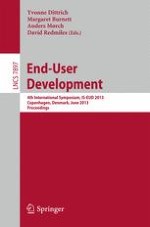2013 | Buch
End-User Development
4th International Symposium, IS-EUD 2013, Copenhagen, Denmark, June 10-13, 2013. Proceedings
herausgegeben von: Yvonne Dittrich, Margaret Burnett, Anders Mørch, David Redmiles
Verlag: Springer Berlin Heidelberg
Buchreihe : Lecture Notes in Computer Science
